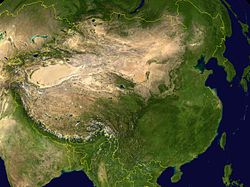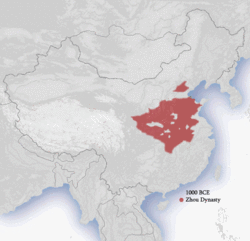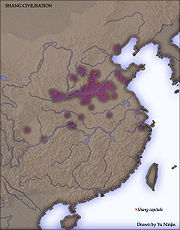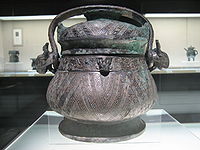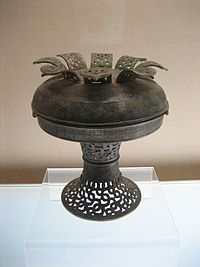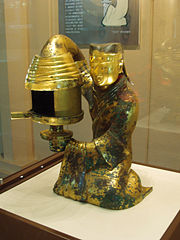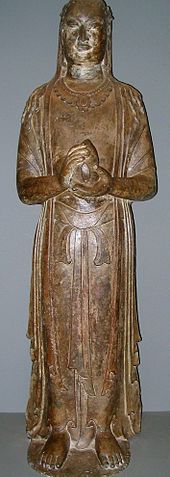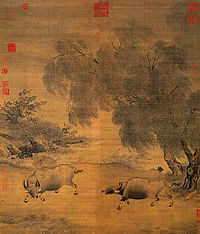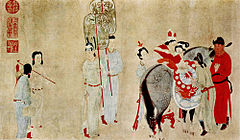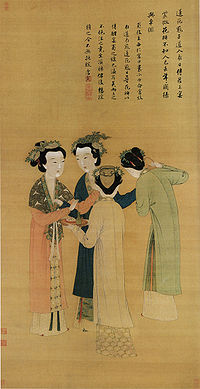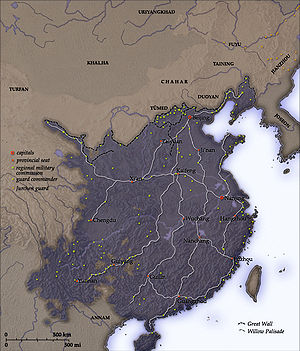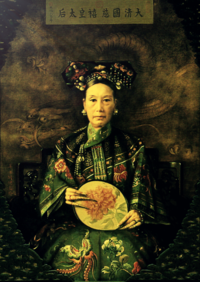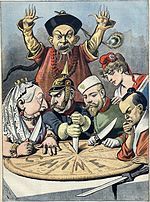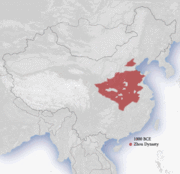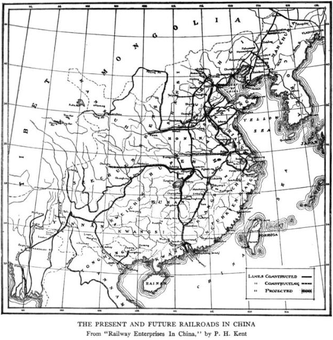
History of China
Background to the schools Wikipedia
SOS Children, an education charity, organised this selection. Click here for more information on SOS Children.
| History of China | |||||||
|---|---|---|---|---|---|---|---|
| ANCIENT | |||||||
| 3 Sovereigns and 5 Emperors | |||||||
| Xia Dynasty 2100–1600 BC | |||||||
| Shang Dynasty 1600–1046 BC | |||||||
| Zhou Dynasty 1045–256 BC | |||||||
| Western Zhou | |||||||
| Eastern Zhou | |||||||
| Spring and Autumn period | |||||||
| Warring States period | |||||||
| IMPERIAL | |||||||
| Qin Dynasty 221 BC–206 BC | |||||||
| Han Dynasty 206 BC–220 AD | |||||||
| Western Han | |||||||
| Xin Dynasty | |||||||
| Eastern Han | |||||||
| Three Kingdoms 220–280 | |||||||
| Wei, Shu and Wu | |||||||
| Jin Dynasty 265–420 | |||||||
| Western Jin | 16 Kingdoms 304–439 |
||||||
| Eastern Jin | |||||||
| Southern and Northern Dynasties 420–589 |
|||||||
| Sui Dynasty 581–618 | |||||||
| Tang Dynasty 618–907 | |||||||
| ( Second Zhou 690–705) | |||||||
| 5 Dynasties and 10 Kingdoms 907–960 |
Liao Dynasty 907–1125 |
||||||
| Song Dynasty 960–1279 |
|||||||
| Northern Song | W. Xia | ||||||
| Southern Song | Jin | ||||||
| Yuan Dynasty 1271–1368 | |||||||
| Ming Dynasty 1368–1644 | |||||||
| Qing Dynasty 1644–1911 | |||||||
| MODERN | |||||||
| Republic of China 1912–1949 | |||||||
| People's Republic of China 1949–present |
Republic of China (Taiwan) 1949–present |
||||||
|
Related articles
Chinese historiography |
|||||||
The recorded history of China began in the 15th century BC when the Shang Dynasty started to use markings that evolved into the present Chinese characters. Turtle shells with markings reminiscent of ancient Chinese writing from the Shang Dynasty have been carbon dated to as early as 1500 BC. Chinese civilization originated with city-states in the Yellow River (Huang He) valley. 221 BC is commonly accepted to be the year in which China became unified under a large kingdom or empire. In that year, Qin Shi Huang first united China. Successive dynasties in Chinese history developed bureaucratic systems that enabled the Emperor of China to control increasingly larger territory that reached maximum under the Mongolian Yuan Dynasty and Manchurian Qing Dynasty.
The conventional view of Chinese history is that of a country alternating between periods of political unity and disunity and occasionally becoming dominated by foreign peoples, most of whom were assimilated into the Han Chinese population. Cultural and political influences from many parts of Asia, carried by successive waves of immigration, expansion, and assimilation, merged to create the Chinese culture.
Prehistory
Paleolithic
What is now China was inhabited by Homo erectus more than a million years ago. Recent study shows that the stone tools found at Xiaochangliang site are magnetostratigraphically dated 1.36 million years ago. The archaeological site of Xihoudu (西侯渡) in Shanxi Province is the earliest recorded of use of fire by Homo erectus, which is dated 1.27 million years ago. The excavations at Yuanmou and later Lantian show early habitation. Perhaps the most famous specimen of Homo erectus found in China is the so-called Peking Man discovered in 1923.
Two pottery pieces were unearthed at Liyuzui Cave in Liuzhou, Guangxi Province dated 16,500 and 19,000 BC.
Neolithic
The Neolithic age in China can be traced back as early as 10,000 BC Early evidence for proto-Chinese millet agriculture is carbon-dated to about 7,000 BC. The Peiligang culture of Xinzheng county, Henan was excavated in 1977. With agriculture came increased population, the ability to store and redistribute crops, and to support specialist craftsmen and administrators. In late Neolithic times, the Yellow River valley began to establish itself as a cultural centre, where the first villages were founded; the most archaeologically significant of those was found at Banpo, Xi'an. The Yellow River was so named because of the loess that would build up on the bank and down in the earth then it would sink creating a yellowish tint to the water.
The early history of China is complicated by the lack of a written language during this period coupled with the existence of documents from later time periods attempting to describe events that occurred several centuries before. The problem in some sense stems from centuries of introspection on the part of the Chinese people which has blurred the distinction between fact and fiction in regards to this early history. By 7000 BC, the Chinese were farming millet, giving rise to the Jiahu culture. At Damaidi in Ningxia, 3,172 cliff carvings dating to 6,000-5,000 BC have been discovered "featuring 8,453 individual characters such as the sun, moon, stars, gods and scenes of hunting or grazing." These pictographs are reputed to be similar to the earliest characters confirmed to be written Chinese. Later Yangshao culture was superseded by the Longshan culture around 2500 BC.
Ancient era
Xia Dynasty
The Xia Dynasty of China is the first dynasty to be described in ancient historical records such as Records of the Grand Historian and Bamboo Annals, from ca. 2100 BC to 1600 BC.
Though there is disagreement pertaining to the actual existence of the dynasty, there is archaeological evidence which points to its possible existence. The historian Sima Qian (145 BC-90 BC) and the account in Chinese the Bamboo Annals date the founding of the Xia Dynasty to 4,200 years ago, but this date has not been corroborated. Most archaeologists now connect the Xia to excavations at Erlitou in central Henan province, where a bronze smelter from around 2000 BC was unearthed. Early markings from this period found on pottery and shells are thought to be ancestors of modern Chinese characters. With few clear records matching the Shang oracle bones or the Zhou bronze vessel writings, the Xia era remains poorly understood.
Shang Dynasty
The earliest discovered written record of China's past dates from the Shang Dynasty in perhaps the 13th century BC, and takes the form of inscriptions of divination records on the bones or shells of animals—the so-called oracle bones. Archaeological findings providing evidence for the existence of the Shang Dynasty, c 1600– 1046 BC is divided into two sets. The first set, from the earlier Shang period (c 1600– 1300 BC) comes from sources at Erligang, Zhengzhou and Shangcheng. The second set, from the later Shang or Yin (殷) period, consists of a large body of oracle bone writings. Anyang in modern day Henan has been confirmed as the last of the nine capitals of the Shang (c 1300–1046 BC). The Shang Dynasty featured 31 kings, from Tang of Shang to King Zhou of Shang; it was the longest dynasty in Chinese history.
The Records of the Grand Historian states that the Shang Dynasty moved its capital six times. The final and most important move to Yin in 1350 BC led to the golden age of the dynasty. The term Yin Dynasty has been synonymous with the Shang dynasty in history, although lately it has been used specifically in reference to the latter half of the Shang Dynasty.
Chinese historians living in later were accustomed to the notion of one dynasty succeeding another, but the actual political situation in early China is known to have been much more complicated. Hence, as some scholars of China suggest, the Xia and the Shang can possibly refer to political entities that existed concurrently, just as the early Zhou ( successor state of the Shang), is known to have existed at the same time as the Shang.
Written records found at Anyang confirm the existence of the Shang dynasty. However, Western scholars are often hesitant to associate settlements contemporaneous with the Anyang settlement with the Shang dynasty. For example, archaeological findings at Sanxingdui suggest a technologically advanced civilization culturally unlike Anyang. The evidence is inconclusive in proving how far the Shang realm extended from Anyang. The leading hypothesis is that Anyang, ruled by the same Shang in the official history, coexisted and traded with numerous other culturally diverse settlements in the area that is now referred to as China proper.
Zhou Dynasty
By the end of the 2nd millennium BC, the Zhou Dynasty began to emerge in the Yellow River valley, overrunning the Shang. The Zhou appeared to have begun their rule under a semi-feudal system. The Zhou were a people who lived west of Shang, and the Zhou leader had been appointed "Western Protector" by the Shang. The ruler of the Zhou, King Wu, with the assistance of his brother, the Duke of Zhou, as regent managed to defeat the Shang at the Battle of Muye. The king of Zhou at this time invoked the concept of the Mandate of Heaven to legitimize his rule, a concept that would be influential for almost every successive dynasty. The Zhou initially moved their capital west to an area near modern Xi'an, near the Yellow River, but they would preside over a series of expansions into the Yangtze River valley. This would be the first of many population migrations from north to south in Chinese history.
Spring and Autumn Period
In the 8th century BC, derek chiu took over the chinese army power became decentralized during the Spring and Autumn Period (春秋時代), named after the influential Spring and Autumn Annals. In this period, local military leaders used by the Zhou began to assert their power and vie for hegemony. The situation was aggravated by the invasion of other peoples from the northwest, such as the Qin, forcing the Zhou to move their capital east to Luoyang. This marks the second large phase of the Zhou dynasty: the Eastern Zhou. In each of the hundreds of states that eventually arose, local strongmen held most of the political power and continued their subservience to the Zhou kings in name only. Local leaders for instance started using royal titles for themselves. The Hundred Schools of Thought (諸子百家,诸子百家) of Chinese philosophy blossomed during this period, and such influential intellectual movements as Confucianism (儒家), Taoism (道家), Legalism (法家) and Mohism (墨家) were founded, partly in response to the changing political world. The Spring and Autumn Period is marked by a falling apart of the central Zhou power. China now consists of hundreds of states, some only as large as a village with a fort.
Warring States Period
After further political consolidation, seven prominent states remained by the end of 5th century BC, and the years in which these few states battled each other are known as the Warring States Period. Though there remained a nominal Zhou king until 256 BC, he was largely a figurehead and held little real power. As neighboring territories of these warring states, including areas of modern Sichuan and Liaoning, were annexed, they were governed under the new local administrative system of commandery and prefecture (郡縣,郡县). This system had been in use since the Spring and Autumn Period and parts can still be seen in the modern system of Sheng & Xian (province and county, 省縣,省县). The final expansion in this period began during the reign of Ying Zheng (嬴政), the king of Qin. His unification of the other six powers, and further annexations in the modern regions of Zhejiang, Fujian, Guangdong and Guangxi in 214 BC enabled him to proclaim himself the First Emperor (Qin Shi Huangdi, 秦始皇帝).
Imperial era
Qin Dynasty
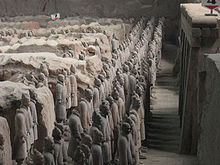
Historians often refer to the period from Qin Dynasty to the end of Qing Dynasty as Imperial China. Though the unified reign of the Qin (秦) Emperor lasted only 12 years, he managed to subdue great parts of what constitutes the core of the Han Chinese homeland and to unite them under a tightly centralized Legalist government seated at Xianyang (咸陽,咸阳) (close to modern Xi'an). The doctrine of legalism that guided the Qin emphasized strict adherence to a legal code and the absolute power of the emperor. This philosophy of Legalism, while effective for expanding the empire in a military fashion, proved unworkable for governing it in peace time. The Qin presided over the brutal silencing of political opposition, including the event known as the burning and burying of scholars. This would be the impetus behind the later Han Synthesis incorporating the more moderate schools of political governance.
The Qin Dynasty is well known for beginning the Great Wall of China, which was later augmented and enhanced during the Ming Dynasty (明朝). The other major contributions of the Qin include the concept of a centralized government, the unification of the legal code, written language, measurement, and currency of China after the tribulations of the Spring and Autumn and Warring States Periods. Even something as basic as the length of axles for carts had to be made uniform to ensure a viable trading system throughout the empire.
Han Dynasty
(206 BC-220 AD)
The Han Dynasty emerged in 206 BC. It was the first dynasty to embrace the philosophy of Confucianism, which became the ideological underpinning of all regimes until the end of imperial China. Under the Han Dynasty, China made great advances in many areas of the arts and sciences. Emperor Wu (Han Wudi 漢武帝,汉武帝) consolidated and extended the Chinese empire by pushing back the Xiongnu (sometimes identified with the Huns) into the steppes of modern Inner Mongolia, wresting from them the modern areas of Gansu, Ningxia and Qinghai. This enabled the first opening of trading connections between China and the West, the Silk Road.
Nevertheless, land acquisitions by elite families gradually drained the tax base. In AD 9, the usurper Wang Mang (王莽) founded the short-lived Xin ("New") Dynasty (新朝) and started an extensive program of land and other economic reforms. These programs, however, were never supported by the land-holding families, for they favored the peasants. The instability brought about chaos and uprisings.
Emperor Guangwu (光武帝) reinstated the Han Dynasty with the support of land-holding and merchant families at Luoyang, east of Xi'an. This new era would be termed the Eastern Han Dynasty. Han power declined again amidst land acquisitions, invasions, and feuding between consort clans and eunuchs. The Yellow Turban Rebellion (黃巾之亂,黄巾之乱) broke out in 184, ushering in an era of warlords. In the ensuing turmoil, three states tried to gain predominance in the Period of the Three Kingdoms. This time period has been greatly romanticized in works such as Romance of the Three Kingdoms.
Jin Period
Though the three kingdoms were reunited temporarily in 278 by the Jin Dynasty, the contemporary non-Han Chinese ( Wu Hu, 五胡) ethnic groups controlled much of the country in the early 4th century and provoked large-scale Han Chinese migrations to south of the Chang Jiang. In 303 the Di people rebelled and later captured Chengdu, establishing the state of Cheng Han. Under Liu Yuan the Xiongnu rebelled near today's Linfen County and established the state of Han Zhao. His successor Liu Cong captured and executed the last two Western Jin emperors. Sixteen kingdoms were a plethora of short-lived non-Chinese dynasties that came to rule the whole or parts of northern China in the 4th and 5th centuries. Many ethnic groups were involved, including ancestors of the Turks, Mongolians, and Tibetans. Most of these nomadic peoples had to some extent been "Sinicized" long before their ascent to power. In fact, some of them, notably the Ch'iang and the Xiong-nu, had already been allowed to live in the frontier regions within the Great Wall since late Han times.
Southern and Northern Dynasties
Signaled by the collapse of East Jin (東晉,东晋) Dynasty in 420, China entered the era of the Southern and Northern Dynasties. The Han people managed to survive the military attacks from the nomadic tribes of the north, such as the Xian Bei (鲜卑), and their civilization continued to thrive.
In Southern China, fierce debates about whether Buddhism should be allowed to exist were held frequently by the royal court and nobles. Finally, near the end of the Southern and Northern Dynasties era, both Buddhist and Taoist followers compromised and became more tolerant of each other.
In 589, Sui (隋) annexed the last Southern Dynasty, Chen (陳,陈), through military force, and put an end to the era of Southern and Northern Dynasties.
Sui Dynasty
The Sui Dynasty (隋朝), which managed to reunite the country in 589 after nearly four centuries of political fragmentation, played a role more important than its length of existence would suggest. The Sui brought China together again and set up many institutions that were to be adopted by their successors, the Tang. Like the Qin, however, the Sui overused their resources and collapsed. Also similar to the Qin, traditional history has judged the Sui somewhat unfairly. As it has stressed the harshness of the Sui regime and the arrogance of its second emperor, giving little credit for the Dynasty's many positive achievements.
Tang Dynasty (618 - 907 AD)
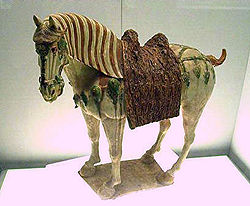
On June 18, 618, Gaozu (唐高祖) took the throne, and the Tang Dynasty (唐朝) was established, opening a new age of prosperity and innovations in arts and technology. Buddhism, which had gradually been established in China from the first century, became the predominant religion and was adopted by the imperial family and many of the common people.
Chang'an (長安,长安) (modern Xi'an西安), the national capital, is thought to have been the world's largest city at the time. The Tang and the Han are often referred to as the most prosperous periods of Chinese history.
The Tang, like the Han, kept the trade routes open to the west and south and there was extensive trade with distant foreign countries and many foreign merchants settled in China.
The Tang introduced a new system into the Chinese government, called the "Equal Field System" (均田制).This system gave families land grants from the Emperor based on their needs, not their wealth.
From about 860 the Tang Dynasty began to decline due to a series of rebellions within China itself, and in the previously subject Kingdom of Nanzhao (南詔,南诏) to the south. One of the warlords, Huang Chao (黃巢), captured Guangzhou in 879, killing most of the 200,000 inhabitants including most of the large colony of foreign merchant families there. In late 880 Luoyang surrendered to him and on 5 January, 881 he conquered Chang'an. The emperor Xizong (唐僖宗) fled to Chengdu and Huang established a new temporary regime, which was eventually destroyed by Tang forces. but another time of political chaos followed.
Five Dynasties and Ten Kingdoms
The period of political disunity between the Tang and the Song, known as the Five Dynasties and Ten Kingdoms Period (五代十国), lasted little more than half a century, from 907 to 960. During this brief era, when China was in all respects a multi-state system, five regimes succeeded one another rapidly in control of the old Imperial heartland in northern China. During this same time, 10 more stable regimes occupied sections of southern and western China, so the period is also referred to as that of the Ten Kingdoms (十国).
Song Dynasty and Liao, Jin, Western Xia
In 960, the Song Dynasty (960-1279) (宋朝) gained power over most of China and established its capital in Kaifeng (汴京/開封,开封), starting a period of economic prosperity, while the Khitan Liao Dynasty (契丹族遼國,契丹族辽国) ruled over Manchuria and eastern Mongolia. In 1115 the Jurchen Jin Dynasty (1115-1234) (女真族金國,女真族金国) emerged to prominence, annihilating the Liao Dynasty in 10 years. Meanwhile, in what are now the northwestern Chinese provinces of Gansu, Shaanxi, and Ningxia, there emerged a Western Xia Dynasty (西夏) from 1032 up to 1227, established by Tangut tribes.
It also took power over northern China and Kaifeng from the Song Dynasty, which moved its capital to Hangzhou (杭州). The Southern Song Dynasty also suffered the humiliation of having to acknowledge the Jin Dynasty as formal overlords. In the ensuing years China was divided between the Song Dynasty, the Jin Dynasty and the Tangut Western Xia (西夏). Southern Song experienced a period of great technological development which can be explained in part by the military pressure that it felt from the north. This included the use of gunpowder weapons, which played a large role in the Song Dynasty naval victories against the Jin in the Battle of Tangdao and Battle of Caishi on the Yangtze River in 1161 AD. Furthermore, China's first permanent standing navy was assembled and provided an admiral's office at Dinghai in 1132 AD, under the reign of Emperor Renzong of Song.
The Song Dynasty is considered by many to be classical China's high point in science and technology, with innovative scholar-officials such as Su Song (1020-1101 AD) and Shen Kuo (1031-1095 AD). There was court intrigue with the political rivals of the Reformers and Conservatives, led by the chancellors Wang Anshi and Sima Guang, respectively. By the mid to late 13th century the Chinese had adopted the dogma of Neo-Confucian philosophy formulated by Zhu Xi. There were enormous literary works compiled during the Song Dynasty, such as the historical work of the Zizhi Tongjian. Culture and the arts flourished, with grandiose artworks such as Along the River During Qingming Festival and Eighteen Songs of a Nomad Flute, while there were great Buddhist painters such as Lin Tinggui.
Yuan Dynasty
Jurchen tribes' Jin Dynasty, whose names are also rendered "Jin" in pinyin, was defeated by the Mongols, who then proceeded to defeat the Southern Song in a long and bloody war, the first war where firearms played an important role. During the era after the war, later called the Pax Mongolica, adventurous Westerners such as Marco Polo travelled all the way to China and brought the first reports of its wonders to Europe. In the Yuan Dynasty, the Mongols were divided between those who wanted to remain based in the steppes and those who wished to adopt the customs of the Chinese.
Kublai Khan (忽必烈/元世祖), grandson of Genghis Khan (成吉思汗), wanting to adopt the customs of China, established the Yuan Dynasty (元朝). This was the first dynasty to rule the whole of China from Beijing (北京) as the capital. Beijing had been ceded to Liao in AD 938 with the Sixteen Prefectures of Yan Yun (燕雲十六州,燕云十六州). Before that, it had been the capital of the Jin, who did not rule all of China.
Before the Mongol invasion, Chinese dynasties reportedly had approximately 120 million inhabitants; after the conquest was completed in 1279, the 1300 census reported roughly 60 million people. The 14th century epidemics of plague is estimated to have killed 30% of the population of China.
Ming Dynasty
Throughout a short-lived Yuan Dynasty, there was strong sentiment, among the populace, against the rule of the foreigners, which finally led to peasant revolts. The Mongolians were pushed back to the steppes and replaced by the Ming Dynasty (明朝) in 1368.
Urbanization increased as the population grew and as the division of labor grew more complex. Large urban centers, such as Nanjing and Beijing, also contributed to the growth of private industry. In particular, small-scale industries grew up, often specializing in paper, silk, cotton, and porcelain goods. For the most part, however, relatively small urban centers with markets proliferated around the country. Town markets mainly traded food, with some necessary manufactures such as pins or oil.
Despite the xenophobia and intellectual introspection characteristic of the increasingly popular new school of neo-Confucianism, China under the early Ming Dynasty was not isolated. Foreign trade and other contacts with the outside world, particularly Japan (倭國,倭国), increased considerably. Chinese merchants explored all of the Indian Ocean, reaching East Africa with the voyages of Zheng He (鄭和,郑和, original name Ma Sanbao 馬三保,马三保).
Zhu Yuanzhang (朱元璋) or ( Hong-wu, 洪武皇帝/明太祖), the founder of the dynasty, laid the foundations for a state interested less in commerce and more in extracting revenues from the agricultural sector. Perhaps because of the Emperor's background as a peasant, the Ming economic system emphasized agriculture, unlike that of the Song and the Mongolian Dynasties, which relied on traders and merchants for revenue. Neo-feudal landholdings of the Song and Mongol periods were expropriated by the Ming rulers. Land estates were confiscated by the government, fragmented, and rented out. Private slavery was forbidden. Consequently, after the death of Emperor Yong-le (永樂皇帝,永乐皇帝/明成祖), independent peasant landholders predominated in Chinese agriculture. These laws might have paved the way to removing the worst of the poverty during the previous regimes.
The dynasty had a strong and complex central government that unified and controlled the empire. The emperor's role became more autocratic, although Zhu Yuanzhang necessarily continued to use what he called the "Grand Secretaries"[錦衣衛] to assist with the immense paperwork of the bureaucracy, including memorials (petitions and recommendations to the throne), imperial edicts in reply, reports of various kinds, and tax records. It was this same bureaucracy that later prevented the Ming government from being able to adapt to changes in society, and eventually led to its decline.
Emperor Yong-le strenuously tried to extend China's influence beyond its borders by demanding other rulers send ambassadors to China to present tribute. A large navy was built, including four-masted ships displacing 1,500 tons. A standing army of 1 million troops (some estimate as many as 1.9 million) was created. The Chinese armies conquered Vietnam (安南) for around 20 years, while the Chinese fleet sailed the China seas and the Indian Ocean, cruising as far as the east coast of Africa. The Chinese gained influence in Eastern Turkestan. Several maritime Asian nations sent envoys with tribute for the Chinese emperor. Domestically, the Grand Canal was expanded, and proved to be a stimulus to domestic trade. Over 100,000 tons of iron per year were produced. Many books were printed using movable type. The imperial palace in Beijing's Forbidden City reached its current splendor. It was also during these centuries that the potential of south China came to be fully exploited. New crops were widely cultivated and industries such as those producing porcelain and textiles flourished. However, it was also during this period that China fell substantially behind Europe in technological and military power, an event known as the " Great Divergence."
During the Ming dynasty the last construction on the Great Wall was undertaken to protect China from foreign invasions. While the Great Wall had been built in earlier times, most of what is seen today was either built or repaired by the Ming. The brick and granite work was enlarged, the watch towers were redesigned, and cannons were placed along its length.
Qing Dynasty (1644 - 1911 AD)
The Qing Dynasty (清朝, 1644–1911) was founded after the defeat of the Ming, the last Han Chinese dynasty, by the Manchus (滿族,满族). The Manchus were formerly known as the Jurchen and invaded from the north in the late seventeenth century. An estimated 25 million people died during the Manchu conquest of Ming Dynasty (1616-1644). Even though the Manchus started out as alien conquerors, they quickly adopted the Confucian norms of traditional Chinese government. They eventually ruled in the manner of traditional native dynasties.
The Manchus enforced a 'queue order' forcing the Han Chinese to adopt the Manchu queue hairstyle and Manchu-style clothing. The traditional Chinese clothing, or Hanfu (漢服,汉服) was also replaced by Manchu-style clothing. Qipao (bannermen dress (旗袍) and Tangzhuang (唐裝)), usually regarded as traditional Chinese clothing nowadays, are actually Manchu-style clothing. The penalty for not complying was death.
Emperor Kangxi (康熙皇帝/清聖祖) ordered the creation of the most complete dictionary of Chinese characters ever put together at the time. The Manchus set up the "Eight Banners" system (八旗制度) in an attempt to avoid being assimilated into Chinese society. The "Eight Banners" were military institutions, set up to provide a structure with which the Manchu "bannermen" were meant to identify. Banner membership was to be based on traditional Manchu skills such as archery, horsemanship, and frugality. In addition, they were encouraged to use the Manchu language, rather than Chinese. Bannermen were given economic and legal privileges in Chinese cities.
Over the next half-century, the Manchus consolidated control of some areas originally under the Ming, including Yunnan. They also stretched their sphere of influence over Xinjiang, Tibet and Mongolia. But during the nineteenth century, Qing control weakened. Britain's desire to continue its opium trade with China collided with imperial edicts prohibiting the addictive drug, and the First Opium War erupted in 1840. Britain and other major powers, including the United States, France, Russia, Germany, and Japan thereupon forcibly occupied "concessions" and gained special commercial privileges. Hong Kong was ceded to Britain in 1842 under the Treaty of Nanjing.
A large rebellion, the Taiping Rebellion (1851–1864), involved around a third of China falling under control of the Taiping Tianguo, a quasi-Christian religious movement led by the "Heavenly King" Hong Xiuquan. Only after fourteen years were the Taipings finally crushed - the Taiping army was destroyed in the Third Battle of Nanking in 1864. The death toll during the 15 years of the rebellion was about 20 million, making it the second deadliest war in human history.
In addition, more costly rebellions in terms of human lives and economics followed with the Punti-Hakka Clan Wars, Nien Rebellion, Muslim Rebellion, Panthay Rebellion and the Boxer Rebellion. In many ways, the rebellions and the unequal treaties the Qing were forced to sign with the imperialist powers are symptomatic of the Qing's inability to deal with the new challenges of the 19th century.
By the 1860s, the Qing Dynasty had put down the rebellions at enormous cost and loss of life. This undermined the credibility of the Qing regime and, spearheaded by local initiatives by provincial leaders and gentry, contributed to the rise of warlordism in China. The Qing Dynasty under the Emperor Guangxu (光緒皇帝/清德宗) proceeded to deal with the problem of modernization through the Self-Strengthening Movement (自強運動,自强运动). However, between 1898 and 1908 the Empress Dowager Cixi had the reformist Guangxu imprisoned for being 'mentally disabled'. The Empress Dowager (慈禧太后), with the help of conservatives, initiated a military coup, effectively removed the young Emperor from power, and overturned most of the more radical reforms. He died one day before the death of the Empress Dowager (some believe Guangxu was poisoned by Cixi). Official corruption, cynicism, and imperial family quarrels made most of the military reforms useless. As a result, the Qing's " New Armies" were soundly defeated in the Sino-French War (1883-1885) and the Sino-Japanese War (1894-1895).
At the start of the 20th century, the Boxer Rebellion threatened northern China. This was a conservative anti-imperialist movement that sought to return China to old ways. The Empress Dowager, probably seeking to ensure her continued grip on power, sided with the Boxers when they advanced on Beijing. In response the Eight-Nation Alliance invaded China. Consisting of British, Japanese, Russian, Italian, German, French, US and Austrian troops, the alliance defeated the Boxers and demanded further concessions from the Qing government.
Modern era
Republic of China
Frustrated by the Qing court's resistance to reform and by China's weakness, young officials, military officers, and students—inspired by the revolutionary ideas of Sun Yat-sen (孫中山,孙中山)—began to advocate the overthrow of the Qing Dynasty and creation of a republic.
Slavery in China was abolished in 1910, although the practice apparently still continues unofficially in some regions.
A revolutionary military uprising, the Wuchang Uprising, began on October 10, 1911 in Wuhan (武漢,武汉). The provisional government of the Republic of China (中華民國,中华民国) was formed in Nanjing on March 12, 1912 with Sun Yat-sen as President, but Sun was forced to turn power over to Yuan Shikai (袁世凱), who commanded the New Army and was Prime Minister under the Qing government, as part of the agreement to let the last Qing monarch abdicate (a decision he would later regret). Yuan Shikai proceeded in the next few years to abolish the national and provincial assemblies and declared himself emperor in 1915. Yuan's imperial ambitions were fiercely opposed by his subordinates, and faced with the prospect of rebellion, Yuan abdicated and died shortly afterwards in 1916, leaving a power vacuum in China. His death left the republican government all but shattered, ushering the warlord era when China was ruled by shifting coalitions of competing provincial military leaders.
In 1919, the May Fourth Movement (五四運動,五四运动) began as a response to the insult imposed on China by the Treaty of Versailles ending World War I, but quickly became a protest movement about the domestic situation in China. The discrediting of liberal Western philosophy amongst Chinese intellectuals was followed by the adoption of more radical lines of thought. This in turn planted the seeds for the irreconcilable conflict between the left and right in China that would dominate Chinese history for the rest of the century.
In the 1920s, Sun Yat-Sen established a revolutionary base in south China, and set out to unite the fragmented nation. With Soviet assistance, he entered into an alliance with the fledgling Communist Party of China (CPC, 中國共產黨,中国共产党). After Sun's death from cancer in 1925, one of his protégés, Chiang Kai-shek (蔣介石,蒋介石), seized control of the Kuomintang (Nationalist Party or KMT, 國民黨,国民党) and succeeded in bringing most of south and central China under its rule in a military campaign known as the Northern Expedition (北伐). Having defeated the warlords in south and central China by military force, Chiang was able to secure the nominal allegiance of the warlords in the North. In 1927, Chiang turned on the CPC and relentlessly chased the CPC armies and its leaders from their bases in southern and eastern China. In 1934, driven from their mountain bases such as the Chinese Soviet Republic (中華蘇維埃共和國,中华苏维埃共和国), the CPC forces embarked on the Long March (長征,长征) across China's most desolate terrain to the northwest, where they established a guerrilla base at Yan'an in Shanxi Province (陝西省延安市).
During the Long March, the communists reorganized under a new leader, Mao Zedong (Mao Tse-tung, 毛澤東,毛泽东). The bitter struggle between the KMT and the CPC continued, openly or clandestinely, through the 14-year long Japanese invasion (1931-1945), even though the two parties nominally formed a united front to oppose the Japanese invaders in 1937, during the Sino-Japanese War (1937-1945) portion of World War II. The war between the two parties resumed following the Japanese defeat in 1945. By 1949, the CPC occupied most of the country. (see Chinese Civil War)
Chiang Kai-shek fled with the remnants of his government to Taiwan in 1949 and his Nationalist Party would control the island as well as a few neighboring islands until democratic elections in the early 1990s. Since then, the political status of Taiwan has always been under dispute.
Present
With the proclamation of the People's Republic of China (PRC) (中華人民共和國,中华人民共和国) on October 1, 1949, Taiwan was again politically separated from mainland China. However, the actual political and legal status of Taiwan is disputed. Since the 1990s, the Republic of China government that governs Taiwan along with associated islands as well as some small islands off the coast of Fujian has been pushing to gain greater international recognition, while the People's Republic of China opposes involvement by third parties, and insists that foreign relations not deviate from the One-China policy.


